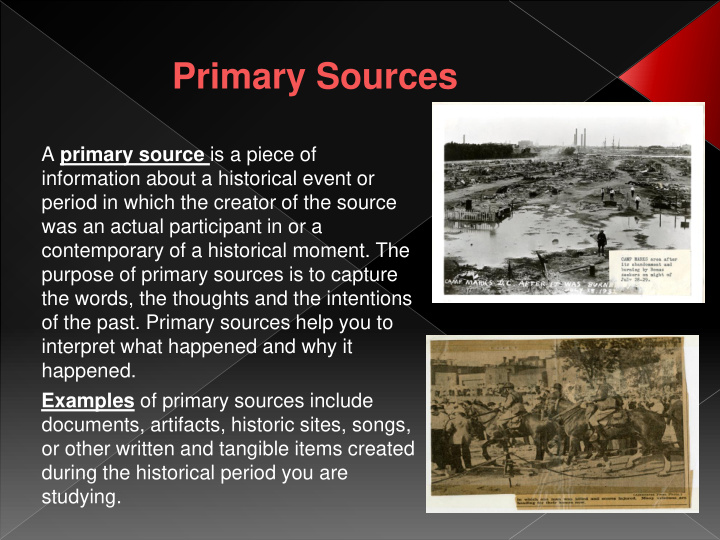



Primary Sources A primary source is a piece of information about a historical event or period in which the creator of the source was an actual participant in or a contemporary of a historical moment. The purpose of primary sources is to capture the words, the thoughts and the intentions of the past. Primary sources help you to interpret what happened and why it happened. Examples of primary sources include documents, artifacts, historic sites, songs, or other written and tangible items created during the historical period you are studying.
• Primary sources include: • Songs • Objects • Cultural Artifacts • Journals/Diaries • Letters • Speeches • Maps • Autobiographies • Government documents • Public Records • Birth/Death/Marriage Certificates • Photographs/Paintings/Drawings • Video Footage • Historic Sites • Oral Histories • Newspapers/Magazine Articles
Secondary Sources A secondary source is a source that was not created first-hand by someone who participated in the historical era. Secondary sources are usually created by historians, but based on the historian's reading of primary sources. Secondary sources are usually written decades, if not centuries, after the event occurred by people who did not live through or participate in the event or issue. The purpose of a secondary source is to help build the story of your research from multiple perspectives and to give your research historical context. An example of a secondary source is Battle Cry of Freedom: The Civil War Era by James M. McPherson, published in 1988. They are a great starting point in helping you see the big picture. Understanding the context of your topic will help you make sense of the primary sources that you find.
• Secondary Sources include: • Biographies • Encyclopedias • Interviews with experts/scholars • School history textbook • Media documentaries about a historic event (i.e. a documentary on The History Channel) • Books written about a topic by a historian • Films about a historical event which were not filmed at the time
Annotated Bibliography An annotated bibliography is required for all categories. The annotations for each source must explain how the source was used and how it helped you understand your topic. You should also use the annotation to explain why you categorized a particular source as primary or secondary. Sources of visual materials and oral interviews, if used, must also be included. List only those sources that you used to develop your entry. An annotation normally should be only 1-3 sentences long. • Source (example): Bates, Daisy. The Long Shadow of Little Rock . 1st ed. New York: David McKay Co. Inc., 1962. • Annotation (example): Daisy Bates was the president of the Arkansas NAACP and the one who met and listened to the students each day. This first-hand account was very important to my paper because it made me more aware of the feelings of the people involved.
Citations • For help with MLA: http://www.library.cornell.edu/resrch/citmanage/mla
Recommend
More recommend